![]()
![]()
![]()
Use LEFT and RIGHT arrow keys to navigate between flashcards;
Use UP and DOWN arrow keys to flip the card;
H to show hint;
A reads text to speech;
137 Cards in this Set
- Front
- Back
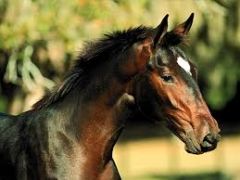
Star |
anywhere above or between eyeline |
|

Strip |
Narrow marking; right below or between before nostril |
|
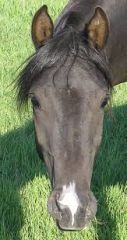
Snip |
anything below nostrils |
|
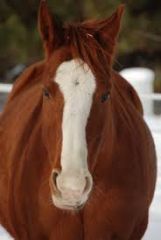
Blaze |
Very wide facial marking; forehead and can include nostril |
|

Bald Face |
Whole face; look out for sunburn |
|
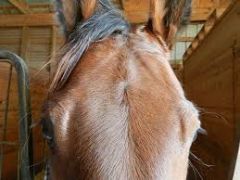
Whorl |
hair has yet to come together and forms a whorl |
|
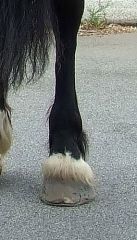
Coronet |
White markings around coronary band |
|
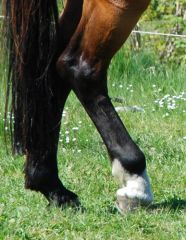
Pastern |
On the pastern |
|
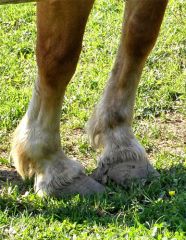
Sock |
Right above fetlock; looks like a sock |
|
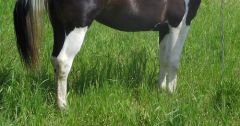
Stocking |
All the way above the tarsus joint |
|
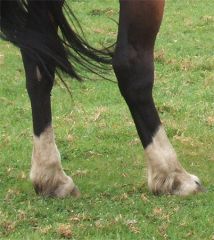
Fetlock |
On fetlock |
|
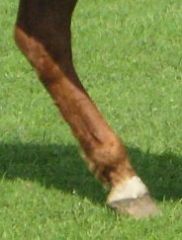
Half Pastern |
Literally half pastern |
|
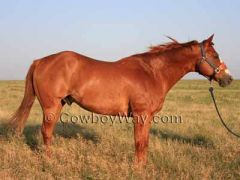
Sorrel |
Common w/ Quarter horses; all one color; mane and tail same color as horse |
|
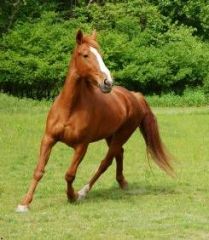
Chestnut |
Arabians; brownish colors |
|
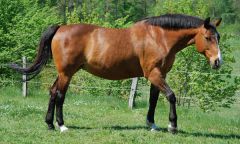
Bay |
Brown body color and black mane and black tail; black on one or all legs |
|
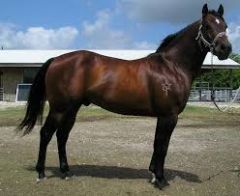
Brown |
Brown around muzzle, eyes, flank, & legs |
|

Black |
Pure black |
|

Palomino |
yellow; can have flax on mane and tai |
|
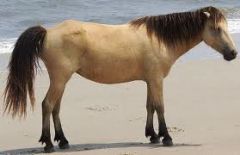
Buckskin |
lighter tan body w/ black mane, tail, and on 1-4 legs |
|
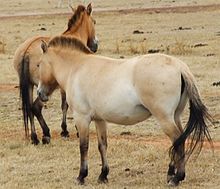
Dun |
Or roan; must have dorsal stripe; zebra stripes on legs |
|
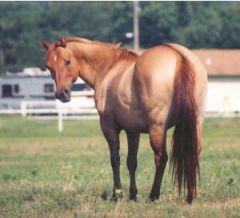
Red Dun |
Strawberry appearance |
|

Grullo |
mingled color; speckled |
|
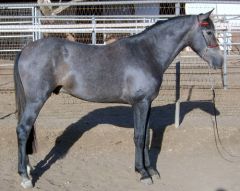
Gray |
Gray |
|
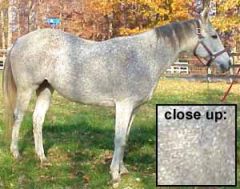
Flea Bitten Gray |
Looks like have fleas everywhere |
|
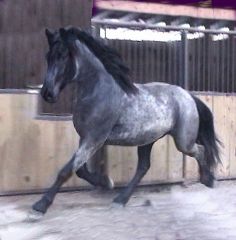
Blue Roan |
Blue mane and tail |
|
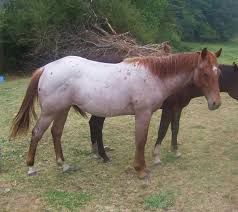
Red Roan |
Red mane and tail |
|
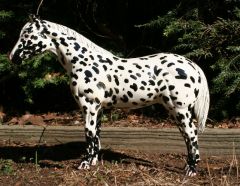
Appaloosa |
Leopard print |
|
|
Paint horse |
literally looks like paint |
|

Tobiano Paint |
Patches "bleed" into rest of coat |
|
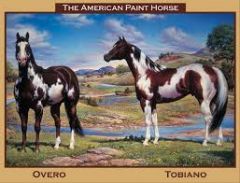
Overo Paint |
Patches clearly defined |
|
|
How are horses measured? |
from the highest point of the withers to the ground |
|
|
What are some different uses for a horse? |
unique & universal, sole weekender, race, sporting, etc. Many varieties |
|
|
1 hand = ? |
4 inches |
|
|
What are the 3 recognized classes of horses? |
Light horse, Draft horse, and Ponies |
|
|
What is the unit used to measure horses? |
hand |
|
|
How are light horses classified? |
by different gaits |
|
|
3 gaits |
walk, trot, canter |
|
|
5 gaits |
walk, trot, canter, rack, slow walk; more sophisticated |
|
|
Common 3 gait Light breeds |
Arabians, Morgans, Quarter Horse, Thoroughbred, American Saddlebred |
|
|
average measurement for light horses |
14.2-17 hands |
|
|
Average weight for light horses |
900-1400lbs |
|
|
Common 5 gait light breeds |
American Saddlebred |
|
|
Which horse can run 1/2 mile without being winded? |
American Quarter Horse |
|
|
Which horse is a known walking horse, also called the "cadillac ride" |
Tennessee Walking Horse |
|
|
Which horse can complete 2 miles at a gallop without being winded? |
Thoroughbred |
|
|
Describe the stock horse |
originates from the Mustang; durable horse; holds largest class of light horses in U.S.; i.e. American Quarter Horse |
|
|
Describe the Polo Pony |
small amount of ponies used during polo event; consist of quarter horses and thoroughbreds; Require speed and stamina |
|
|
Describe Hunter Jumper horses |
Thoroughbreds and European breeds; excellent athletes; springing action added to feet; endurance horses |
|
|
Average height for draft horses |
14.2-17.2 hands |
|
|
Average weight for draft horses |
>1400lbs. |
|
|
Primary use for draft horses |
pulling heavy loads and doing heavy work |
|
|
Describe a draft horse |
heavy boned, heavy muscled, very calm and relaxed |
|
|
Average height for pony |
<14.2 |
|
|
Average weight for pony |
500-900lbs |
|
|
What are ponies used for? |
recreational use |
|
|
Describe ponies |
most pony registries measure by inches; very durable but bossy; like toy breeds of dogs |
|
|
Dam |
female parent |
|
|
Colt |
young male intact up to 3-4 years or breeding age |
|
|
Weanling |
young horse of either sex at weaning age or less than 1 year |
|
|
Cryptorchid |
testicles remain in inguinal region; bilateral or unilateral |
|
|
Sire |
male parent |
|
|
Stallion |
"stud" intact male of breeding age over 3 |
|
|
Yearling |
Male or female; between 1-2 years of age |
|
|
Hand |
measurement of height for horses |
|
|
Foal |
newborn of either sex less than 1 year |
|
|
Mare |
mature female |
|
|
Foal heat |
first heat cycle after parturition 7-10 days after foaling |
|
|
Founder |
common term for laminitis |
|
|
Filly |
young female up to 3-4 years or to breeding age |
|
|
Gelding |
castrated male of any age |
|
|
Proud cut |
incomplete castration that causes the horse to have stud-like behavior |
|
|
Cribber |
when bored, will hang front teeth on something and breath heavily |
|
|
Neigh |
welcome sound; greeting when any number of horses meet; separation call when mare and foal are separated; open-mouth when comfortable with owner will neigh at owner |
|
|
Nicker |
soft, closed-mouth sound that mare makes to foal nostril movement |
|
|
Snort |
frightened; loud to let whoever is around know they're here |
|
|
Squeal |
alarm other horses; defense greeting when 2 strangers meet |
|
|
Roar |
from stallion when he is wanting to let mares know he is there; open mouth |
|
|
normal Ears |
up front; alert |
|
|
ears when aggressive |
pinned back |
|
|
submissive ears |
relaxed; half drooped |
|
|
relaxed ears |
normale |
|
|
nervous ears |
pinned; alert; anything really |
|
|
Pawing ground |
when nervous or frightened |
|
|
listening ears |
the ears are cocked over |
|
|
scent marking |
different scent glands |
|
|
flehman |
when stallion checks to see if mare is in heat |
|
|
Which side do you approach a horse and why? |
Left side because it is near sighted |
|
|
Genus and species |
Equus caballus |
|
|
Sites for pulse on a horse |
facial artery, transverse facial artery, lateral dorsal medial tarsal artery, lateral digital artery, tail artery |
|
|
Sites for respiration on a horse |
flank area and can count the movement of nostrils |
|
|
TPR of horses |
T: 99min - 100avg. - 101 max P: 25min. - 35avg. - 50 max R: 8min. - 12avg. - 20 max |
|
|
ID Methods |
lip tattoo, freeze brand, hot brand |
|
|
Lip tattoo |
common in thoroughbreds and warm bloods |
|
|
Freeze brand |
causes discoloration in hair growth; gray-white hair depending on the brand |
|
|
Hot brand |
very rare in equine med.; will not discolorate; will see scarring area |
|
|
Tooth care |
constant dental work; horses grind when chewing |
|
|
Dental floats |
manually done; 1. during eating of hay, grain, grass - gets hung up in oral cavity and falls 2. Fowl odor 3. whole particle grains seen in feces |
|
|
Conformation of horses |
body conditioning can be hereditary; angle of shoulder in relation to front legs; length of coffin bone in relation to humerus; straightness of forelegs; angle between stifle, hock, and pastern; head, neck, & back |
|
|
Estrous cycle in horses |
mare in standing heat to stallion; happens every 21 days |
|
|
Estrus |
lasts 4-7 days |
|
|
Teasing |
stallion will be introduced to the mare; mare's vulva will look like it is winking; receptive at highest peak; stallion could bite |
|
|
Breeding |
ovulation occurs 24-48 hours before the end of estrus; egg will release 6 hours after fertilization; check between 10-14 days after conception; day 21: confirm heartbeat |
|
|
Gestation |
330-345 days |
|
|
How long is sperm viable for? |
30 hours in mare |
|
|
Pasture breeding |
stallion free to run and breed at large; con: breeding dates |
|
|
Artificial Insemenation |
semen collected and chilled or frozen and can inseminate a mare |
|
|
Hand mating |
mare and stallion are restrained; mare prepped with a vaginal wash if necessary; penal wash for the stallion; pro: can know the dates |
|
|
Mare prep |
must have proper care, vaccines must be given to mare & deworming; double the food |
|
|
Foaling and parturition |
artificial time; must be stress free environment |
|
|
right time for foaling |
typically 11pm-7am; good environment: middle of pasture; sun is best disinfectant |
|
|
"bagging up" |
mare's utter becomes full of milk; at least 3-4 weeks before foaling |
|
|
"waxing over" |
mare 10 days prior - utter will look waxy |
|
|
Water breaks |
3-4 hours before foaling; 2.5 gallons of water |
|
|
Delivery |
after delivery; shed placenta |
|
|
resting period |
after birth |
|
|
normal presentation |
both front feet then nose, shoulder blades, body, hips, and back legs |
|
|
Neonatal care |
foal will stand after a few minutes; must check for patent airway for foal; begin routine care when umbilical cord breaks; clear the airway and dip the naval in 2% iodine or chlorexidine solution to prevent naval ill; dip within the first 24 hours; check physical condition and any abnormalities; tetanus injection w/ toxoid or antitoxin; check for first bowl movement - usually black and tar like; use enema if straining; if placenta doesn't pass it can cause infections |
|
|
Foal heat |
first heat cycle after foaling is 7-9 days after giving birth; most fertile and can rebreed if no problems with delivery |
|
|
Weaning |
no age/ depends on breeder and mare's physical condition; foal's ability to eat grain and future plans of foal; stressful time so separate the mare and foal; when weaning, use stall with a companion |
|
|
Average range for weaning |
4-6 months |
|
|
Mastitis when weaning |
fix by reducing daily intake of food and help with milk production; check utter daily; heat, redness, no milk |
|
|
Castration |
performed 1-2 years old; performed in cool weather to help with inflammation and no flies; watch for cryptorchidism |
|
|
List two metabollic disorders |
colic and laminitis |
|
|
Colic |
not specific disease but a condition resulting from abdominal pain; pain can come from internal and external causes; most common cause: excessive motility of intestine which causes overproduction & gas; other causes: estrous, internal parasites, ingestion of large quantities of grain, ingestion of sand or moldy hays; external causes: stress; intestines can become twisted or obstructed; horse will sweat, strain, groan, roll, kick, and bite at flank or abdomen; prevent horse from rolling; |
|
|
Laminitis |
common "founder" condition within vessels in hoof walls (lamina); become engorged with blood producing, extreme pain, rotate downward and exit bottom of sole if not fixed; causes: overeating, consumption of fresh grasses esp. Fesbue; overconsumption of cold water before cooling after exercise uterine infection equine cushings disease severe colic |
|
|
Equine Influenza |
highly contagious, virual, flu-like symptoms: coughing, nasal discharge, fever, depression, anorexia; preventable by vaccine |
|
|
Navel Ill |
"joint ill" fatal or cripping disease of newborn foals caused by bacteria entering the body; naval cord is the common enter place; causes inflamed naval, hot, swollen joints, lameness, no vaccine; naval dip |
|
|
Equine Encephalomyelitis |
Sleeping sickness; viral; transmitted by mosquitoes; cause: Central nervous system disturbances, high death rate; Signs: depression, fever, ataxia, nerve disorders, more prevalent in warmer months; vaccination is recommended in spring, summer, and fall |
|
|
Strangles |
equine distemper; highly contagious; caused by streptococcus equi; stress, exposure to wet conditions, cold weather, shipping via trailer, fatigue, respiratory infections; signs: fever, loss of appetite, nasal discharge, swelling of glands under mandible which may rupture and drain pus; treated with antibiotics; complete isolation; remain infectious up to 6 weeks; pre-exposed |
|
|
Bastard Strangles |
Abscess anywhere else but under the mandible |
|
|
Equine Infectious Anemia |
EIA; "swamp fever" viral infection transmitted via flies and mosquitoes; signs: high fever, labored breathing, pounding heartbeat, exhaustion, leg weakness, diarrhea, swelling of sheath, chest, and legs; death can occur w/in 30 days; if recovered, immune to virus but is now a carrier; no vaccine; good ectoparasite control and performing Coggin's test |
|
|
Tetanus |
locked jaw; highly fatal neurologic disease caused by anaerobic clostridium tetni bacteria; signs: stiffness w/ head and neck, spasms, hypersensitivity to noise and movement; recovery = very slow; only if animal kept hydrated with adequate nutrition test if 3 months since previous vaccine |
|
|
Equine Herpes Virus |
respiratory disease of young horses; causes: abortions in pregnant mares; vaccinated at 3rd, 5th, 7th, and 9th month of pregnancy if in an area common for carrying the virus |
|
|
West Nile Virus |
passed by mosquitoes; seen in birds; affects nervous system; symptoms similar to encephalitis but with muscle trembles; vaccine unavailable since 2001; "flavivirus" |
|
|
Potomic Horse Fever |
caused by ehrlichoristicii; signs: diarrhea, fever, abortion, laminitis; vaccine - mainly recommended for horses in eastern U.S. and near water |
|
|
EPM |
Equine Protozoa Myelitis; caused by protozoan parasites; comes from possums; transmitted by fecal oral; affects central nervous system; causes spinal ataxia, weakness, and muscle atrophy; Tx: antiprotozoal drugs; no vaccines; best prevented by fresh food every morning |
|
|
Rabies |
zoonotic; transmitted: rabid skunk, fox, or bat; signs: fever, hindlimb ataxia, hyperstesia - hypersensitivity to touch; progress to more neurological signs |

